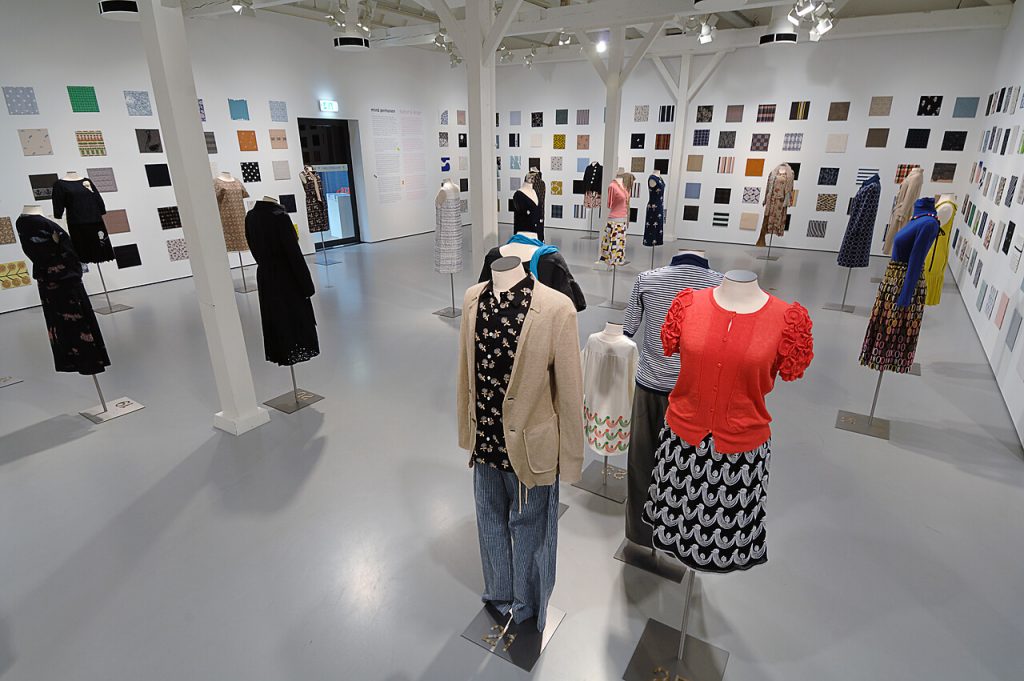Minä Perhonen: Fashion and Design
minä perhonen – fashion & design
Exhibition of the work of the Japanese poetical designer Akira Minagawa
The collection of the fashion and design label minä perhonen can best be described as timeless, whimsical and with a great deal of feeling for minute details. The label is founded by designer Akira Minagwa (1967).
From 24 October 2009 through 28 February 2010 Audax Textielmuseum Tilburg presents an outline exhibition of the labels work. Apart from the fashion collection that sells all over the world, interior and furnishing fabrics are part of the collection. These are produced by the Danish company Kvadrat. Fritz Hansen, also Danish, sells Arne Jacobson chairs (the Egg, the Swan, the series 7) covered with fabrics from mina perhonen.
Under his label Akira Minagawa also designed a few pieces of furniture. In 2008 a small porcelain collection brought onto the market and recently the label drew for a print for the famous storm umbrella of Senz.
In his work Akira Minagawa and his designers are continuously looking for the boundaries of whatis technically achievable. That results in fine details that are hidden as small surprises in his clothing and fabrics. Using various weaving, printing and embroidery machines in combination with traditional handwork, they combine old and new techniques in a wayward manner.
Who is Akira Minagawa?
Akira Minagawa (Tokyo 1967), educated at the famous Bunka Fashion College in Tokyo, started his fashion label in 1995. In 2000 he opened a first fashion store in Tokyo, but in 2003 he decided to change the name of his label to minä perhonen. minä perhonen means i, the butterfly in Finnish. In this way Minagawa refers to his passion for the culture of Scandinavia and the symbol of the butterfly in the open air. The butterfly became the new logo of the fashion label: it is a series of scrawly drawings that symbolise these butterflies that move, experiment and grow. In this way they characterise the work of Minagawa that can best be summarised as a constant and continuous process, in which all the fabrics, prints and pieces of embroidery recur in new forms.
Starting in 2004, minä perhonen was presented both in Paris and Tokyo during the fashion week. In 2006 he received the prestigious Japanese Mainichi Fashion Grand Prix prize. In 2007 heopened a second store in Kyoto. In 2008 he began designing porcelain. In the Netherlands minä perhonen is sold by Tamago in Amsterdam.
For more information about the designer, visit: http://www.minä-perhonen.jp
minä perhonen and fashion
Now that the international fashion world falls more and more under the spell of durability and attention to craftsmanship, is minä perhonen more and more often put forward as an important representative of this new spirit of the age. What is exceptional is that he radically breaks the tenacious fashion rule that everything can only last for one season and must then make way for something new. The clothes can cover more than one season, because the fine details in the fabrics, the prints and the pieces of embroidery form the core of the designs: they are used again in each new collection, such as the pieces of embroidery called forest parade or forest girl.
Forest parade Forest girl
Thus each piece of clothing is an artisanate tour de force that can go beyond the fashion trend of one season. minä perhonen also uses the same ingenious material constructions in the design materials that it designs for Kvadrat.
Special attention to fabrics we already saw earlier with important Japanese fashion designers such as Commes des Garçons from Rei Kawakubo, Junya Watanabe and Issey Miyake. They, too, applied themselves to combinations of new technologies mixed with centuries old Japanese traditions. Akira Minagawa can be seen as a new and fresh talent, because he has come up with a completely new expression and language, arising from his more poetic vision, which is also based on durability.
Exhibition in Tilburg
More than fifty outfits from the minä perhonen label can be seen at the exhibition. In addition, attention is paid to interior textiles, the covered chairs, the porcelain and fashion accessories. Four woven plaids are also being shown, which the designer had produced in the TextileLab especially for the exhibition and for the museum collection.
Bordering on the exhibition area is a place fitted out with work made in Japan by the (young) Dutch fashion designer Sanne Janssen. Jansen met Minagawa at a master class that he gave in the TextileMuseum. There he offered her an apprenticeship in Tokyo and brought her into contact with the Japanese fashion industry and fashion stores. http://www.sannejansen.com
The exhibition has been put together by guest curator José Teunissen, lecturer in fashion design at the ArtEZ Hogeschool voor de Kunsten in Arnhem and Visiting Professor University of the Arts in London, in collaboration with Akira Minagawa and Hanneke Oosterhof, head of Presentation and Collection at the Textile Museum.
The layout has been taken care of by Dorell.Ghotmeh.Tane / Architects in Paris. The graphic design is by Frederik de Wal. The exhibition has been brought about with a financial contribution by the Japan Foundation.
The book mina perhonen – fashion & design (Dutch/English) is published for the exhibition. Full colour, 72 p. ISBN 978-90-70962-45-6. Authors: José Teunissen, Alain Debret and Hanneke Oosterhof. € 14,90. The publication is for sale in the museums Textile Shop. In the shop various products from minä perhonen are for sale such as bags and children t-shirts and the plaids woven in the TextileLab.
During the exhibition the designers Sanne Jansen, Joy Boutrop and Malene Krisitansen are giving work shops.
See www.textielmuseum.nl
TextielAcademie.
Audax Textielmuseum Tilburg
Goirkestraat 96, Tilburg
Tuesday to Friday 10:00 to 17:00
Saturday and Sunday 12:00 to 17:00
Telephone 013 5367475
www.textielmuseum.nl
Image courtesy of TextielMuseum. Photo Joep Vogels.
